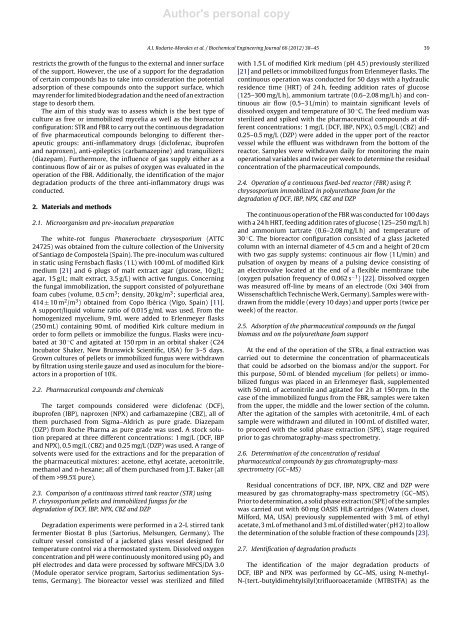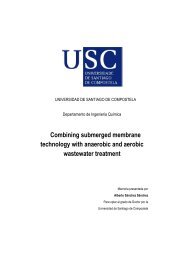Author's personal copy - Universidade de Santiago de Compostela
Author's personal copy - Universidade de Santiago de Compostela
Author's personal copy - Universidade de Santiago de Compostela
You also want an ePaper? Increase the reach of your titles
YUMPU automatically turns print PDFs into web optimized ePapers that Google loves.
<strong>Author's</strong> <strong>personal</strong> <strong>copy</strong>A.I. Rodarte-Morales et al. / Biochemical Engineering Journal 66 (2012) 38–45 39restricts the growth of the fungus to the external and inner surfaceof the support. However, the use of a support for the <strong>de</strong>gradationof certain compounds has to take into consi<strong>de</strong>ration the potentialadsorption of these compounds onto the support surface, whichmay ren<strong>de</strong>r for limited bio<strong>de</strong>gradation and the need of an extractionstage to <strong>de</strong>sorb them.The aim of this study was to assess which is the best type ofculture as free or immobilized mycelia as well as the bioreactorconfiguration: STR and FBR to carry out the continuous <strong>de</strong>gradationof five pharmaceutical compounds belonging to different therapeuticgroups: anti-inflammatory drugs (diclofenac, ibuprofenand naproxen), anti-epileptics (carbamazepine) and tranquilizers(diazepam). Furthermore, the influence of gas supply either as acontinuous flow of air or as pulses of oxygen was evaluated in theoperation of the FBR. Additionally, the i<strong>de</strong>ntification of the major<strong>de</strong>gradation products of the three anti-inflammatory drugs wasconducted.2. Materials and methods2.1. Microorganism and pre-inoculum preparationThe white-rot fungus Phanerochaete chrysosporium (ATTC24725) was obtained from the culture collection of the Universityof <strong>Santiago</strong> <strong>de</strong> <strong>Compostela</strong> (Spain). The pre-inoculum was culturedin static using Fernsbach flasks (1 L) with 100 mL of modified Kirkmedium [21] and 6 plugs of malt extract agar (glucose, 10 g/L;agar, 15 g/L; malt extract, 3.5 g/L) with active fungus. Concerningthe fungal immobilization, the support consisted of polyurethanefoam cubes (volume, 0.5 cm 3 ; <strong>de</strong>nsity, 20 kg/m 3 ; superficial area,414 ± 10 m 2 /m 3 ) obtained from Copo Ibérica (Vigo, Spain) [11].A support/liquid volume ratio of 0.015 g/mL was used. From thehomogenized mycelium, 9 mL were ad<strong>de</strong>d to Erlenmeyer flasks(250 mL) containing 90 mL of modified Kirk culture medium inor<strong>de</strong>r to form pellets or immobilize the fungus. Flasks were incubatedat 30 ◦ C and agitated at 150 rpm in an orbital shaker (C24Incubator Shaker, New Brunswick Scientific, USA) for 3–5 days.Grown cultures of pellets or immobilized fungus were withdrawnby filtration using sterile gauze and used as inoculum for the bioreactorsin a proportion of 10%.2.2. Pharmaceutical compounds and chemicalsThe target compounds consi<strong>de</strong>red were diclofenac (DCF),ibuprofen (IBP), naproxen (NPX) and carbamazepine (CBZ), all ofthem purchased from Sigma–Aldrich as pure gra<strong>de</strong>. Diazepam(DZP) from Roche Pharma as pure gra<strong>de</strong> was used. A stock solutionprepared at three different concentrations: 1 mg/L (DCF, IBPand NPX), 0.5 mg/L (CBZ) and 0.25 mg/L (DZP) was used. A range ofsolvents were used for the extractions and for the preparation ofthe pharmaceutical mixtures: acetone, ethyl acetate, acetonitrile,methanol and n-hexane; all of them purchased from J.T. Baker (allof them >99.5% pure).2.3. Comparison of a continuous stirred tank reactor (STR) usingP. chrysosporium pellets and immobilized fungus for the<strong>de</strong>gradation of DCF, IBP, NPX, CBZ and DZPDegradation experiments were performed in a 2-L stirred tankfermenter Biostat B plus (Sartorius, Melsungen, Germany). Theculture vessel consisted of a jacketed glass vessel <strong>de</strong>signed fortemperature control via a thermostated system. Dissolved oxygenconcentration and pH were continuously monitored using pO 2 andpH electro<strong>de</strong>s and data were processed by software MFCS/DA 3.0(Module operator service program, Sartorius sedimentation Systems,Germany). The bioreactor vessel was sterilized and filledwith 1.5 L of modified Kirk medium (pH 4.5) previously sterilized[21] and pellets or immobilized fungus from Erlenmeyer flasks. Thecontinuous operation was conducted for 50 days with a hydraulicresi<strong>de</strong>nce time (HRT) of 24 h, feeding addition rates of glucose(125–300 mg/L h), ammonium tartrate (0.6–2.08 mg/L h) and continuousair flow (0.5–3 L/min) to maintain significant levels ofdissolved oxygen and temperature of 30 ◦ C. The feed medium wassterilized and spiked with the pharmaceutical compounds at differentconcentrations: 1 mg/L (DCF, IBP, NPX), 0.5 mg/L (CBZ) and0.25–0.5 mg/L (DZP) were ad<strong>de</strong>d in the upper port of the reactorvessel while the effluent was withdrawn from the bottom of thereactor. Samples were withdrawn daily for monitoring the mainoperational variables and twice per week to <strong>de</strong>termine the residualconcentration of the pharmaceutical compounds.2.4. Operation of a continuous fixed-bed reactor (FBR) using P.chrysosporium immobilized in polyurethane foam for the<strong>de</strong>gradation of DCF, IBP, NPX, CBZ and DZPThe continuous operation of the FBR was conducted for 100 dayswith a 24 h HRT, feeding addition rates of glucose (125–250 mg/L h)and ammonium tartrate (0.6–2.08 mg/L h) and temperature of30 ◦ C. The bioreactor configuration consisted of a glass jacketedcolumn with an internal diameter of 4.5 cm and a height of 20 cmwith two gas supply systems: continuous air flow (1 L/min) andpulsation of oxygen by means of a pulsing <strong>de</strong>vice consisting ofan electrovalve located at the end of a flexible membrane tube(oxygen pulsation frequency of 0.062 s −1 ) [22]. Dissolved oxygenwas measured off-line by means of an electro<strong>de</strong> (Oxi 340i fromWissenschaftlich Technische Werk, Germany). Samples were withdrawnfrom the middle (every 10 days) and upper ports (twice perweek) of the reactor.2.5. Adsorption of the pharmaceutical compounds on the fungalbiomass and on the polyurethane foam supportAt the end of the operation of the STRs, a final extraction wascarried out to <strong>de</strong>termine the concentration of pharmaceuticalsthat could be adsorbed on the biomass and/or the support. Forthis purpose, 50 mL of blen<strong>de</strong>d mycelium (for pellets) or immobilizedfungus was placed in an Erlenmeyer flask, supplementedwith 50 mL of acetonitrile and agitated for 2 h at 150 rpm. In thecase of the immobilized fungus from the FBR, samples were takenfrom the upper, the middle and the lower section of the column.After the agitation of the samples with acetonitrile, 4 mL of eachsample were withdrawn and diluted in 100 mL of distilled water,to proceed with the solid phase extraction (SPE), stage requiredprior to gas chromatography-mass spectrometry.2.6. Determination of the concentration of residualpharmaceutical compounds by gas chromatography-massspectrometry (GC–MS)Residual concentrations of DCF, IBP, NPX, CBZ and DZP weremeasured by gas chromatography-mass spectrometry (GC–MS).Prior to <strong>de</strong>termination, a solid phase extraction (SPE) of the sampleswas carried out with 60 mg OASIS HLB cartridges (Waters closet,Milford, MA, USA) previously supplemented with 3 mL of ethylacetate, 3 mL of methanol and 3 mL of distilled water (pH 2) to allowthe <strong>de</strong>termination of the soluble fraction of these compounds [23].2.7. I<strong>de</strong>ntification of <strong>de</strong>gradation productsThe i<strong>de</strong>ntification of the major <strong>de</strong>gradation products ofDCF, IBP and NPX was performed by GC–MS, using N-methyl-N-(tert.-butyldimehtylsilyl)trifluoroacetami<strong>de</strong> (MTBSTFA) as the
















